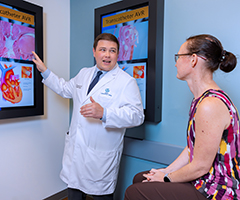Cardiology Glossary of Terms
A
Ablation — The removal, isolation, or destruction of cardiac tissue or conduction pathways involved in arrhythmias.
Algorithm — A set of precise rules or procedures programmed into a pacemaker or defibrillator that are designed to solve a specific problem.
Antiarrhythmic Drugs — Medicine that corrects irregular heartbeats and slows down heartbeats that beat too fast.
Antitachycardia Pacing (ATP) — Short, rapid, carefully controlled sequences of pacing pulses delivered by an ICD and used to terminate a tachycardia in the atria or ventricles.
Arrest (Cardiac) — Failure of the heart to pump blood through the body. If left untreated, it is dangerous and life-threatening.
Arrhythmia — Any heart rhythm that falls outside the accepted norms.
Atrial fibrillation (AF) — Very fast, a disorganized heart rhythm that starts in the atria.
Atrial Flutter (AFL) — Fast, organized atrial rhythm.
Atrial Tachycardia (AT) — A rapid heart rate that starts in the atria (includes AF, and AFL)
Atrioventricular (AV) Node — A section of specialized neuromuscular cells that are part of the normal conduction pathway between the atria and the ventricles. (A junction that conducts electrical impulses from the atria to the ventricles of the heart.)
Atrioventricular (AV) Synchrony — The normal activation sequence of the heart in which the atria contract and then, after a brief delay, the ventricles contract. AV Synchrony optimizes the heart's output of blood and produces the greatest efficiency of the cardiovascular system.
Atrium — The heart is divided into four chambers. Each of the two upper chambers is called an atrium. (Atria is the plural form of the atrium.) Either of the two upper chambers of the heart, above the ventricles, receive blood from the veins and communicates with the ventricles through the tricuspid (right) or mitral (left) valve.
B
Bradycardia ( Bradyarrhythmia) — A heart rate that is abnormally slow; commonly defined as under 60 beats per minute or a rate that is too slow to physiologically support a person and their activities.
C
Cardiac Arrest — Failure of the heart to pump blood through the body. If left untreated, it is dangerous and life-threatening.
Cardioversion — The process of restoring the heart's normal rhythm by applying a controlled electric shock to the exterior of the chest.
Chronic lead — A pacemaker or ICD lead that has been implanted in the past.
Chronotropic incompetence — The inability of the heart to increase its rate appropriately in response to increased activity or metabolic need, e.g., exercise, illness, etc.
D
Defibrillation — The Process in which an electronic device sends an electric shock to stop an extremely rapid or irregular heartbeat, and restore the normal heart rhythm.
Diagnostics — Data gathered by an ICD or pacemaker to evaluate patient rhythm status, verify system operation, or assure appropriate delivery of therapy options.
Dual-Chamber Pacemaker — A pacemaker with two leads (one in the atrium and one in the ventricle) to allow pacing and/or sensing in both chambers of the heart to artificially restore the natural contraction sequence of the heart.
E
Ejection Fraction — A measure of the output of the heart with each heartbeat.
Electrocardiogram (ECG) — A printout from an electrocardiography machine used to measure and record the electrical activity of the heart.
Electromagnetic Interference (EMI) — Equipment and appliances that use magnets and electricity have electromagnetic fields around them. If these fields are strong, they may interfere with the operation of the ICD.
Electrophysiology (EP) Study — The use of programmed stimulation protocols to assess the electrical activity of the heart to diagnose arrhythmias.
F
Fibrillation — A chaotic and unsynchronised quivering of the heart during which no effective pumping occurs. Fibrillation may occur in the atria or the ventricles.
H
Heart Block — A condition in which electrical impulses are not conducted in the normal fashion from the atria to the ventricles. May be caused by damage or disease processes within the heart.
Hemodynamics — The forces involved in circulating blood through the cardiovascular system. The heart adapts its hemodynamic performance to the needs of the body, increasing its output of blood when muscles are working and decreasing output when the body is at rest.
Holter monitoring — A technique for the continuous recording of electrocardiographic (ECG) signals, usually over 24 hours, to detect and diagnose ECG changes. (Also called ambulatory monitoring.)
I
ICD — Abbreviation for Implantable Cardioverter Defibrillator. An ICD is an implanted device used to treat abnormal, fast heart rhythms. Several types of therapies are used by the ICD, including cardioversion, defibrillation, and antitachycardia pacing.
Ischaemia — Insufficient blood flow to tissue due to blockage in the blood flow through the arteries.
L
Lead — In an ICD system, the wire or catheter which conducts energy from the ICD to the heart, and from the heart to the ICD.
Left ventricular dysfunction — A heart condition in which the heart is unable to maintain normal cardiac output due to a deficiency in the left ventricle.
M
Myocardial infarction — Death of a portion of the heart muscle tissue due to a blockage or interruption in the supply of blood to the heart muscle.
Myocardium — The middle and the thickest layer of the heart wall, composed of cardiac muscle.
P
Premature atrial contraction (PAC) — A contraction in the atrium which is initiated by an ectopic focus and occurs earlier than the next expected normal sinus beat.
Premature ventricular contraction (PVC or VPD) — A contraction in the ventricle which is initiated by an ectopic focus and occurs earlier than the next expected normal sinus or escape rhythm beat.
S
Sinoatrial (SA) Node — The heart's natural pacemaker located in the right atrium. Electrical impulses originate here and travel through the heart, causing it to beat.
Sudden cardiac death (SCD) — Death due to cardiac causes within 1 hour of the onset of symptoms, with no prior warning.
Supraventricular tachycardia (SVT) — A rapid heartbeat originating from above the ventricles.
Syncope — Fainting, loss of consciousness, or dizziness which may be due to a change in cardiac rhythm (arrhythmia) or other causes.
T
Tachycardia (Tachyarrhythmia) — Rapid beating of either or both chambers of the heart, usually defined as a rate over 100 beats per minute.
V
Ventricle — One of the two lower chambers of the heart. (See Atrium)
Ventricular Fibrillation (VF) — Very fast, chaotic, quivering heart contractions that start in the ventricles. During VF, the heart does not beat properly. This often results in fainting. If left untreated, it may result in cardiac arrest. Blood is not pumped from the heart to the rest of the body. Death will occur if defibrillation is not initiated within 6 minutes from the onset of VF.
Ventricular Tachycardia (VT) — A rapid heart rate that starts in the ventricles. During VT, the heart does not have time to fill with enough blood between heartbeats to supply the entire body with sufficient blood. It may cause dizziness and light-headedness.
Common Abbreviations
- AA: Antiarrhythmic
- AF: Atrial fibrillation
- ATP: Antitachycardia pacing
- AVID: Antiarrhythmics Versus Implantable Defibrillators study
- CABG: Coronary artery bypass graft
- CAD: Coronary artery disease
- CASH: Cardiac Arrest Study Hamburg
- CHD: Coronary heart disease
- CHF: Congestive heart failure
- DFT: Defibrillation threshold
- EF: Ejection fraction
- EP: Electrophysiologic
- EPS: Electrophysiologic Study
- HCM: Hypertrophic cardiomyopathy
- ICD: Implantable cardioverter defibrillator
- LOS: Length of stay
- LQTS: Long Q-T syndrome
Learn More About Cardiovascular Services at Lee Health
-
Heart Institute
Start your heart care journey here. An umbrella for all of Lee Health's cutting edge cardiovascular care options.
-
Cardiology - Heart Institute at Bass Road
-
Cardiology - Heart Institute at Cape Coral Hospital
-
Cardiology - Heart Institute at Coconut Point
-
Cardiology - Heart Institute at Metro Parkway
-
Cardiology - Heart Institute at Medical Plaza One
-
Cardiology - Heart Institute at Sanctuary




